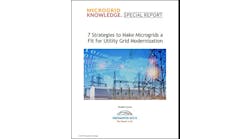AES has proposed that Puerto Rico consider a redesign of its grid into a network of regional minigrids powered by up to 10,000 MW of solar and 2,500 MW of battery storage.
The Virginia-based global energy company recently put forward the idea in response to an inquiry underway at the Puerto Rico Energy Commission. The commission is seeking suggestions on how to decentralize its electric grid to avoid a repeat of the kind of collapse wrought by Hurricane Maria. Nearly 2 ½ months after the storm, more than 30 percent of the island remains without power.
Call them microgrids or minigrids, the idea emerged from a brain trust of experts that AES brought together. The company contributed its inside knowledge of the island, where it has acted as a power producer for 15 years.
The minigrids would not only significantly increase power reliability, but also could save the island money, according to Chris Shelton, AES chief technology officer.
AES calculates that the upfront capital cost for the minigrid project would be less than what it costs to fuel Puerto Rico’s existing generation over 10 years. This is based on AES’ initial assessment that puts large scale solar PV at roughly $40-50/MWh, and long duration (10-hour) battery storage at about $55-65/MWh.
The minigrids would spare the island the kind of cascading outages that occurred during Hurricane Maria. Damage to long-distance transmission lines cut power delivery from generators on one side of the island to populated regions on the other side.
In contrast, the minigrids would be situated close to those they serve, so would not be subject to the vulnerability of transmission lines. AES designed the system to serve 70 percent of load with local distribution lines – no transmission connection.
Minigrids reduce need to import fuel
Because each minigrid uses solar, it spares the island from the need to import fuel, which became scarce following the storm.
Further, the solar and storage would be distributed throughout each minigrid, not located all in one place, to avoid central points of failure.
AES decided to call the units minigrids rather than microgrids because they are larger than typical microgrids.
“We’re not trying to pick a semantic war,” Shelton said. “The commission is very focused on microgrids. We wanted to draw a distinction from traditional concepts of microgrids.”
Further, the minigrid system is characterized by use of the existing distribution system as the core and organizing principle, he said. Microgrids, on the other hand, tend to be situated around specific electrical loads, such as hospitals or other critical facilities.
[clickToTweet tweet=”Is a Network of Mini-grids the Answer for Puerto Rico? #microgrid @aes_es” quote=”Is a Network of Mini-grids the Answer for Puerto Rico?”]
AES had only 10 days to come up with the plan because of the commission’s November 20 deadline for comment. It collected experts — “the image should be Ph.ds eating pizza all sitting in a conference room” — to devise a system that could restore power quickly and limit outages proportional to the damage, he said.
As it is now, the island’s heavy reliance on transmission makes it disproportionately vulnerable to hardship when the lines go down. Damage to 20 percent of a transmission line can mean power loss to 100 percent who are served by the line. On the other hand, 20 percent damage to the distribution system may mean only 30 percent of customers lose power – which is why the AES solutions depends heavily on the distribution, not the transmission system.
“If a couple of [distribution] poles in a neighborhood go down, that neighborhood goes down. With transmission, it could be an entire region,” he said.
Under the minigrid concept, some low-cost centralized power plants could continue to operate to help serve the island’s 3,000 MW load. Inefficient, high cost generators would be either shut down or re-purposed into another form of power capacity.
Solar plant held up in hurricane
Building 10,000 MW of solar would require use of 1-2 percent of the island’s land. The plan could work with less solar, he said, as little as 5,000 MW of solar — using less land.
But what if the solar panels are damaged in a hurricane?
Shelton pointed out that during Hurricane Maria, only six percent of the panels at AES’ 24-MW solar DC site were damaged, even though the plant took a direct hit by the hurricane.
“The system was designed for a hurricane from the beginning. It worked,” he said.
Join the discussion about microgrids and minigrids at Microgrid 2019.
Batteries would be even more resilient in a storm, since they are in buildings. The batteries would be able to supply most of the island’s load for 10 hours.
Others forms of renewables, such as wind, could also be incorporated.
“There are many possible ways you could do this,” Shelton said.
AES wants to share the minigrid idea with stakeholders and refine it further. The company does not see itself as the sole developer or operator, although it could play a role
“This is a vision, not a plan,” Shelton said. “It’s meant to encourage thinking. It’s an organizational vision that could drive change in the marketplace.”
Call them microgrids, minigrids or something else, but don’t miss the news about them. Subscribe to the free Microgrid Knowledge newsletter.






